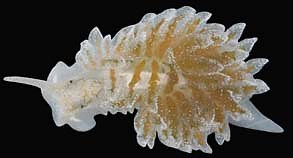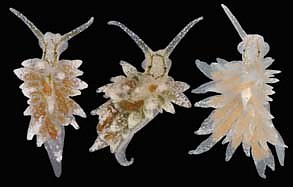
Ercolania cf. coerulea
Order: SACOGLOSSA
Superfamily: LIMAPONTIOIDEA
Family: Limapontiidae
PHOTO
12 mm. On Dictyosphaeria cavernosa in 0.5 m. Treasure Cay, Abaco, Bahamas. June 27, 1999. Has damaged rhinophore. Photo: Colin
See Colin Redfern's message and Kathe Jensen's reply discussing this species and Ercolania sp. 3 and their relationship to Elysia coerulea.
Authorship detailsRudman, W.B., 2002 (March 25) Ercolania cf. coerulea [In] Sea Slug Forum. Australian Museum, Sydney. Available from http://www.seaslugforum.net/find/ercocfcoer
Related messages
Re: Ercolania coerulea from the Bahamas
March 27, 2002
From: Kathe R. Jensen
Dear Bill, Colin and Lucas,
This is a difficult one. I think there may be 2 species in Colin's photos:
• The 3 specimens in the top photo are not what I have been calling Ercolania coerulea. The digestive gland has only one major branch in the head and not extending to the tip of the rhinophores. Also, the cerata are not as inflated as in E. coerulea.
• The specimen in the lower photo is a little more dubious: it has a fine network of digestive gland tubules in the head, but I cannot see if it extends into the rhinophores. Also, it has a broad foot, which is spatulate in the front - as in the animals I have been calling E. coerulea. However, the cerata are not very inflated.
I do not have Schmekel and Portmann's book here in Thailand, but I remember the blue markings on the cerata in their colour plate. This I have only seen in animals feeding on certain species of Valonia, never in animals from Dictyosphaeria. If my memory is correct they also have a figure (or at least a drawing) of the egg mass, which has a very characteristic appearance with the tiny white eggs arranged in a lace-like pattern. The egg masses are usually much more conspicuous than the animals, which are almost indistinguishable from the "bubbles" of Dictyosphaeria.
So, I would suggest that Colin's message is divided into an Ercolania sp. for the top specimens (there is at least one undescribed in the Caribbean), and an Ercolania cf. coerulea for the specimen on the lower photo.
Greetings,
Kathe
jensen@ait.ac.th
Jensen, K.R., 2002 (Mar 27) Re: Ercolania coerulea from the Bahamas. [Message in] Sea Slug Forum. Australian Museum, Sydney. Available from http://www.seaslugforum.net/find/6523Thanks Kathe,
This sounds a bit like the 'Placida dendritica' story. I have split the two 'species'onto separate pages, Ercolania sp. 3 and Ercolania cf. coerulea.
Cheers,
Bill Rudman
Re: Ercolania coerulea from the Bahamas
March 20, 2002
From: Juan Lucas Cervera
Dear Bill,
I think that the Colin's Ercolania from Bahamas is not E. coerulea. This is an uncommon Mediterranean species. You can find a good description in Schmekel and Portmann's book (1982). Moreover, you can find a photo of a living animal in the Erwin Koehler's Opisthobranch Web page. The photo has not a high quality, but you can recognize some of the characteristic features of the species.
Regards.
Lucas.
lucas.cervera@uca.es
Cervera, J.L., 2002 (Mar 20) Re: Ercolania coerulea from the Bahamas. [Message in] Sea Slug Forum. Australian Museum, Sydney. Available from http://www.seaslugforum.net/find/6501Thanks Lucas,
My understanding was that this species was quite variable in colour. I look forward to some guidance from Kathe Jensen.
Cheers,
Bill Rudman
Ercolania coerulea from the Bahamas
March 18, 2002
From: Colin Redfern


Note added 26 March 2002: See Kathe Jensen's message suggesting there are probably two species in this message.
Dear Bill,
Ercolania coerulea was mentioned recently in a message from Kathe Jensen, and I am attaching some photos of this species from Abaco, Bahamas. Small examples of this species - (from 2 to 5 mm) - occur in Abaco on a variety of algae, including Caulerpa racemosa, C. verticillata, Cladosiphon occidentalis, Cladophora and Dictyosphaeria cavernosa. The only large specimens that I've found have been on Dictyosphaeria.
UPPER PHOTO: (left to right):
• 3 mm. On Cladosiphon occidentalis in 1 m. Fish Cays, Abaco, Bahamas. July 7, 1992.
• 3 mm. On Caulerpa verticillata, just below the water line on a seawall. Treasure Cay, Abaco, Bahamas. June 30, 1991.
• 4 mm. On Dictyosphaeria cavernosa attached to a sponge in 1 m. Treasure Cay, Abaco, Bahamas. July 22, 1998. Has damaged rhinophore.
LOWER PHOTO:
• 12 mm. On Dictyosphaeria cavernosa in 0.5 m. Treasure Cay, Abaco, Bahamas. June 27, 1999. Has damaged rhinophore.
Best wishes,
Colin
bahamianseashells@att.net
Redfern, C., 2002 (Mar 18) Ercolania coerulea from the Bahamas. [Message in] Sea Slug Forum. Australian Museum, Sydney. Available from http://www.seaslugforum.net/find/6310Thanks Colin,
Bill Rudman
